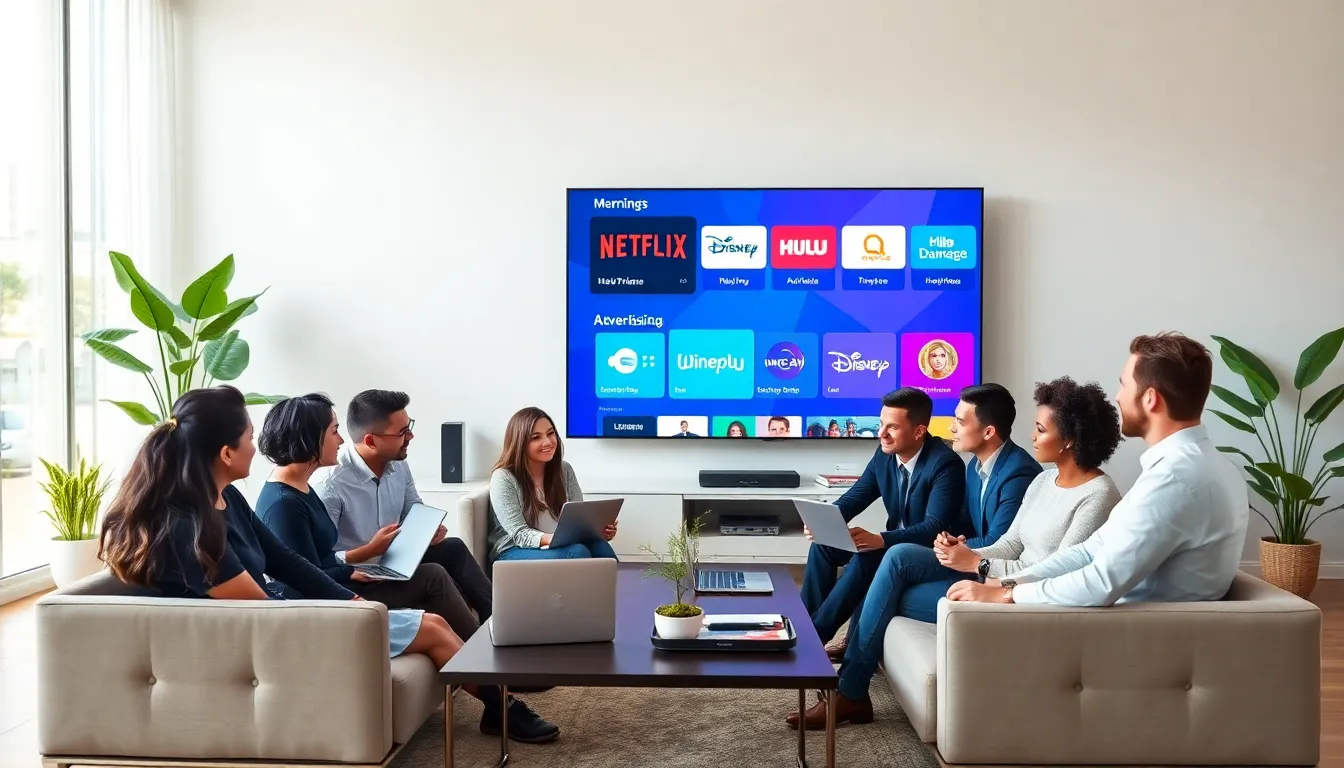In a world where flipping through channels feels as dated as dial-up internet, streaming TV advertising is turning heads and changing the game. Gone are the days of yelling at an infomercial during Commercial Break No. 5, viewers are now in control, choosing what to watch and when. With the rise of streaming platforms, businesses have discovered a shiny new playground to reach audiences like never before. And if you thought that TV advertising was on life support, think again: it’s just gotten a major facelift. This article will explore how streaming TV advertising has risen to prominence, the benefits it offers, challenges marketers face, effective targeting solutions, future trends, and some jaw-dropping case studies that illustrate its remarkable potential. So, grab your snack and settle in.
Table of Contents
ToggleThe Rise of Streaming TV Advertising

The world of television has undergone a major transformation, and streaming platforms are at the forefront of this evolution. With the convenience and flexibility they offer, it’s no surprise that platforms like Netflix, Hulu, and Disney+ have attracted millions of viewers. According to recent statistics, more than 80% of U.S. households now subscribe to at least one streaming service. This shift has not only changed how people consume content but also how brands approach advertising. Traditional TV advertising is losing ground, as viewers turn to ad-free subscription models or simply bypass commercials with the click of a button. In response, advertisers are shifting their strategies to reach audiences in this new digital landscape. Streaming TV advertising is rapidly becoming an essential component of a comprehensive marketing strategy, enticing brands to adapt and innovate.
Streaming platforms offer advertisers new avenues for creativity, allowing them to engage audiences through targeted and interactive campaigns. Advertisers are waking up to the fact that streaming TV is where the eyeballs, and potential customers, are. As this trend continues to gain momentum, brands that embrace streaming will not just survive, they will thrive.
Key Benefits of Streaming TV Advertising
Streaming TV advertising comes with a wide array of benefits that make it an appealing choice for marketers. Here are some of the most compelling advantages:
Enhanced Targeting Options
Unlike traditional TV advertising, which uses broad demographics, streaming services allow advertisers to target their audiences based on interests, behaviors, and viewing habits. This precision enables brands to reach the right consumers at the right time, leading to higher engagement rates.
Cost-Effectiveness
Streaming ads often have a lower cost per impression compared to traditional television. Brands can invest in relevant content while still maintaining a flexible budget. Smaller companies, in particular, now have a fighting chance to compete against larger players.
Real-Time Analytics
With streaming TV, gone are the days of waiting weeks to learn the success of an ad campaign. Instant feedback via real-time analytics provides advertisers with insights into viewer engagement, allowing them to adjust their strategies on the fly. It’s like having a crystal ball for marketing.
Higher Engagement Levels
Streaming platforms often provide interactive advertising opportunities. Viewers can click on ads and engage directly, leading to better retention and fewer skipped ads. When consumers feel actively involved, they’re more likely to remember brand messages.
Wide Reach
Streaming TV advertising can extend beyond traditional geographical limitations and reach a global audience. Whether you’re a local business or a multinational corporation, streaming lets you cast a net far and wide, capturing consumers wherever they are.
Challenges in Streaming TV Advertising
While there are numerous advantages to streaming TV advertising, marketers should also be wary of potential challenges:
Ad Fatigue
With so many advertisers vying for attention, ad fatigue is a real concern. Consumers might become tired of seeing the same ads repeatedly, leading to diminished effectiveness. Advertisers must be creative to keep their content fresh.
Fragmentation of Platforms
The sheer number of streaming platforms can be overwhelming. Each platform caters to different demographics and viewing habits. This fragmentation can make it challenging for advertisers to develop a cohesive, effective strategy that spans multiple services.
Measurement Metrics
While real-time analytics are a perk, the metrics used to measure success can vary significantly across platforms. Disparate metrics can cause confusion when trying to gauge campaign effectiveness or return on investment. Establishing standard benchmarks across platforms is crucial for reliable measurement.
Viewer Privacy
As advertisers collect data to create tailored experiences, privacy concerns become a key issue. Strict regulations and consumer skepticism about data usage can hinder efforts to build meaningful connections with audiences. Transparency and ethical practices are essential in building trust.
Targeting and Measurement Solutions
In the competitive landscape of streaming TV advertising, targeting and measurement solutions play a pivotal role in maximizing ROI. Brands need to equip themselves with the right tools:
Advanced Audience Segmentation
Using data analytics, advertisers can segment their audience down to specific groups based on behaviors and preferences. This allows for more personalized ad experiences. Brands can even tailor their messages to resonate with different segments, ensuring relevance and maximizing impact.
Cross-Platform Measurement Tools
Investing in cross-platform measurement tools can provide a more unified understanding of campaign performance. These tools help brands analyze data from multiple streaming services, offering a clearer picture of audience behavior and engagement metrics.
Programmatic Advertising
Through automation and AI, programmatic advertising simplifies the purchasing process and allows for real-time adjustments based on performance. This system saves time and enhances targeting capabilities while ensuring brands get the most bang for their buck.
A/B Testing
Conducting A/B tests is crucial for understanding which ad versions resonate best with viewers. Marketers can experiment with different creatives, formats, and calls to action, refining their strategies for optimal performance.
Future Trends in Streaming TV Advertising
The landscape of streaming TV advertising is poised for further transformation. Here are some future trends that marketers can anticipate:
Increased Personalization
As technology advances, personalization will take center stage. Advertisements that adapt to viewer preferences and habits will become commonplace, providing unique experiences tailored to individual tastes.
Integration of Augmented Reality
Imagine viewers being able to interact with brands in real-time using augmented reality (AR) ads. As AR technology becomes more mainstream, advertisers may harness its capabilities to create captivating, immersive experiences.
Enhanced Programmatic Advertising
Expect programmatic advertising to become even more sophisticated, allowing for seamless integration across devices. The rise of artificial intelligence will help marketers make better decisions, automating ad placements for optimal performance.
Growing Focus on Sustainability
Naturally, the future of advertising must take into account consumer values, including sustainability. Brands committed to ethical practices will not only connect on a deeper level with users but also increase their appeal and brand loyalty.
Expanding Global Reach
As streaming services continue to expand their footprint, advertisers will have opportunities to tap into diverse markets worldwide. Tailoring campaigns to meet cultural nuances will be essential for capturing global audiences.
Case Studies of Successful Streaming TV Campaigns
Jump into specific case studies that showcase how innovative brands have thrived through streaming TV advertising:
Case Study 1: Doritos
Doritos launched a multi-platform streaming campaign during a popular sports event, cleverly integrating user-generated content to engage audiences. Viewers could submit their own ad ideas, generating buzz and votes on social media. This campaign resulted in a 30% increase in brand recall and a 20% rise in sales.
Case Study 2: Old Spice
Old Spice took to streaming platforms featuring interactive ads, allowing users to click and explore various products right from their screens. This campaign led to a 50% increase in sales and solidified Old Spice’s identity as a fun and innovative brand.
Case Study 3: Nike
In a campaign focusing on inclusivity and empowerment, Nike turned to streaming platforms to tell powerful stories that resonate with diverse audiences. By doing so, they saw a significant uplift in brand perception, with loyal customers flocking to their latest collections.








